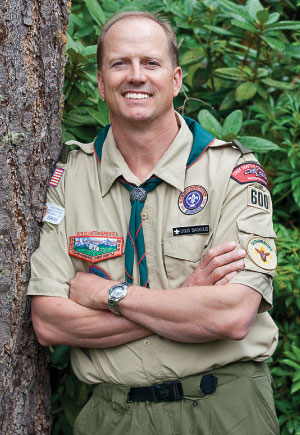
Dr. Douglas D. Backous
How do you measure the success of your Scouting program? This Scoutmaster operates with surgical precision.
Dr. Douglas D. Backous has proven his talent for inspiring and developing young people in two different arenas. He is the Scoutmaster of Troop 600, which recently marked its 50th anniversary with an Eagle Court of Honor for 11 Scouts. That’s a record for the most Eagles earned at once in the Chief Seattle Council. As a youth, he earned the rank of Life Scout, and he is a Brotherhood Member of the Order of the Arrow. Backous also is a surgeon, who teaches residents and interns at Virginia Mason Medical Center in Seattle.
 DR. DOUGLAS D. BACKOUS Scouter Since: 2007 Home: Bellevue, Wash. Current position: Scoutmaster, Troop 600 Day Job: Ear and skull-base surgeon, Virginia Mason Medical Center, Seattle Proudest moment: When our troop earned extra money with a fundraiser this year, they came up with the idea -- on their own -- to spend it on a camp-out with an underprivileged troop. They're learning lessons about giving tithes of time and resources. |
Do you see any similarities between teaching medicine and guiding Boy Scouts?
When you’re teaching surgery to an intern or resident, at some point you have to give him or her the instrument. As a student progresses, he or she is allowed to do more. The student can’t do a reconstruction without first mastering a basic incision. There’s a lot of similarity with that in Scouting. You’re sequentially building confidence in kids.
Both are about finding the right opportunities to let people advance with competence and confidence. If you put them ahead too fast and they fail, they may never get beyond that level.
On the other hand, you’ve also got to know when to push somebody. Recently, on a canoe trip with my 17-year-old son, we encountered 40-mile-per-hour head winds and big waves. I looked at my son and said, “Whatever you do, keep this boat upright. I trust you.” We got through those waves, and he was a different kid five minutes later.
Eleven of your troop members—a quarter of the 44 boys—became Eagle Scouts this year. What happened?
First, we had a group of boys who joined Scouts together at the same time, and they challenged each other. Also, a point of motivation for them was, wouldn’t it be cool to get your Eagle in time for the troop’s 50th anniversary?
Some people might look at those numbers and wonder if Troop 600 is an “Eagle Scout mill.” How would you respond?
Nobody got expressed through the process. Every one of those 11 Scouts worked their tails off. In fact, there were two kids who weren’t quite ready, and we had to tell them. We couldn’t invalidate the work of the 11 Scouts by giving the award to two kids who hadn’t yet earned it.
We do have a process to help guide our Scouts with the timing of their Eagle projects. Once we had a Scout who had to redo his entire Eagle project because he neglected to get a key signature. He was a super kid, and he redid the project cheerfully. But, as a result, we worked hard to create a structure so that if a kid wants to do the work and get Eagle, he can.
Do you put a high priority on Eagle in your troop?
We do not set a goal for how many Eagles we’re going to have, but everybody’s going to have the chance. If 10 Scouts want to become Eagle, and they really try, all 10 can make it. Unlike many competitive sports, Scouting is a program where everybody can win. And if you help somebody else win, you get extra recognition.
The more important measure, for me, is this: How many kids went into our Scouting program and are better people as a result? That’s a tough metric to generate, but that’s what we’re really after—developing good, solid citizens who contribute to society.